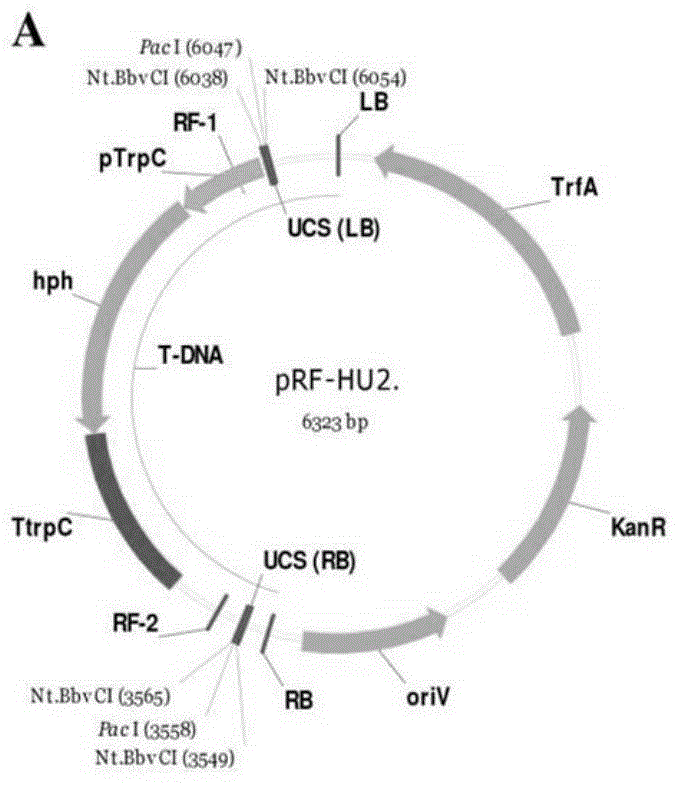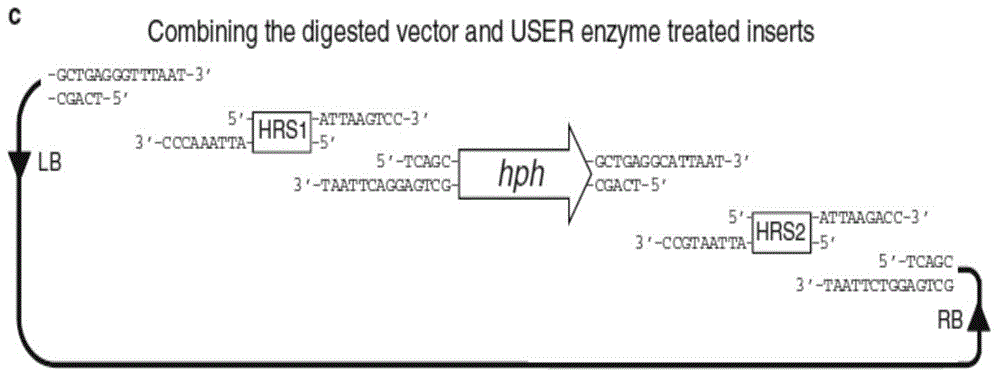Use of verticillium dahliae pathogenicity associated protein VdpdaAl
A technology of Verticillium dahliae, pathogenicity, used in applications, fungicides, fungi, etc.
- Summary
- Abstract
- Description
- Claims
- Application Information
AI Technical Summary
Problems solved by technology
Method used
Image
Examples
Embodiment 1
[0107] Example 1. Preparation of Verticillium dahliae VdpdaA1 knockout mutant
[0108] 1. Preparation of recombinant Agrobacterium pRF-HU2::PDA1
[0109] Using the genomic DNA of the wild-type strain V592 (V592 strain) of the cotton Verticillium wilt strain (V.dahliae) as a template, PCR amplification was carried out with PDA1up-s and PDA1up-x as primers to obtain PCR amplification The product was named as the left homology arm fragment of the VdpdaA1 gene;
[0110]The genomic DNA of the V592 strain was used as a template, and PDA1down-s and PDA1down-x were used as primers for PCR amplification to obtain a PCR amplification product, which was named the right homology arm fragment of the VdpdaA1 gene.
[0111] PacI and Nt.BbvCI restriction endonucleases were used to double-digest the pRF-HU2 vector ( figure 1 ) to obtain two linearized fragments of the pRF-HU2 vector.
[0112] Ligate the fragment of the left homology arm of the VdpdaA1 gene and the fragment of the right homo...
Embodiment 2
[0150] Example 2. Phenotype of complementary mutants
[0151] 1. Construction of complementary vector
[0152] 1. Take the genomic DNA of the V592 strain as a template, and carry out PCR amplification with PDA1-s and PDA1-x as primers to obtain a PCR amplification product, which is identified as the VdpdaA1 gene by agarose gel electrophoresis ( Figure 9 ), including the start codon ATG and the stop codon TAG, with a size of 988 bp. Using water as a template, the above experiments were performed as a negative control. The nucleotide sequence of the PCR product is the nucleotide sequence shown in positions 36 to 1023 of SEQ ID No. 3.
[0153] 2. Use restriction endonuclease SalI and SpeI double enzyme to cut the PCR amplification product of the VdpdaA1 gene obtained in step 1 to obtain the target gene fragment; insert the target gene fragment into the carrier pSULPH-mut-RG#PB (its nucleotide sequence As shown in SEQ ID No. 6) between the SalI and SpeI recognition sites, othe...
PUM
 Login to View More
Login to View More Abstract
Description
Claims
Application Information
 Login to View More
Login to View More - R&D
- Intellectual Property
- Life Sciences
- Materials
- Tech Scout
- Unparalleled Data Quality
- Higher Quality Content
- 60% Fewer Hallucinations
Browse by: Latest US Patents, China's latest patents, Technical Efficacy Thesaurus, Application Domain, Technology Topic, Popular Technical Reports.
© 2025 PatSnap. All rights reserved.Legal|Privacy policy|Modern Slavery Act Transparency Statement|Sitemap|About US| Contact US: help@patsnap.com



